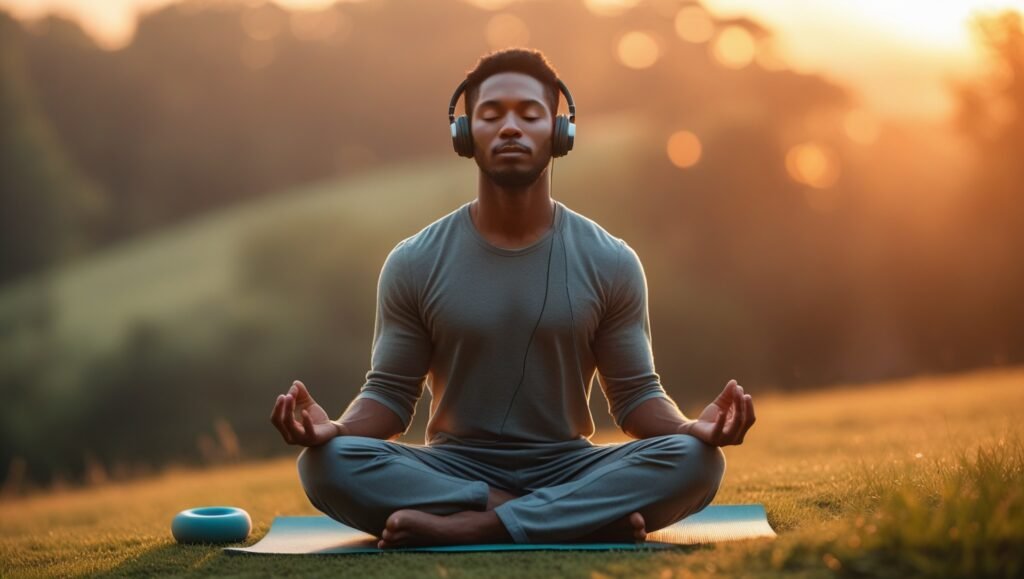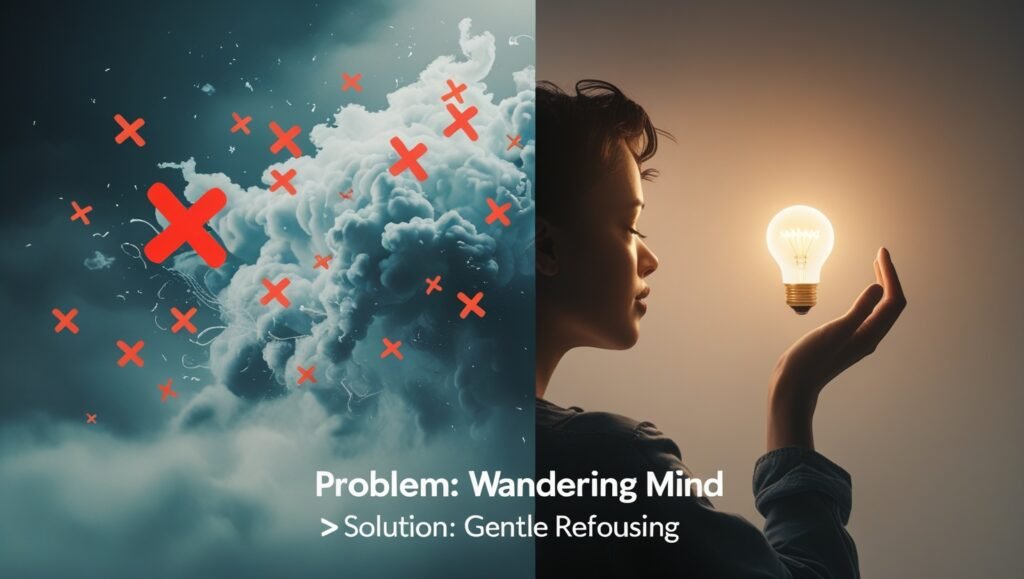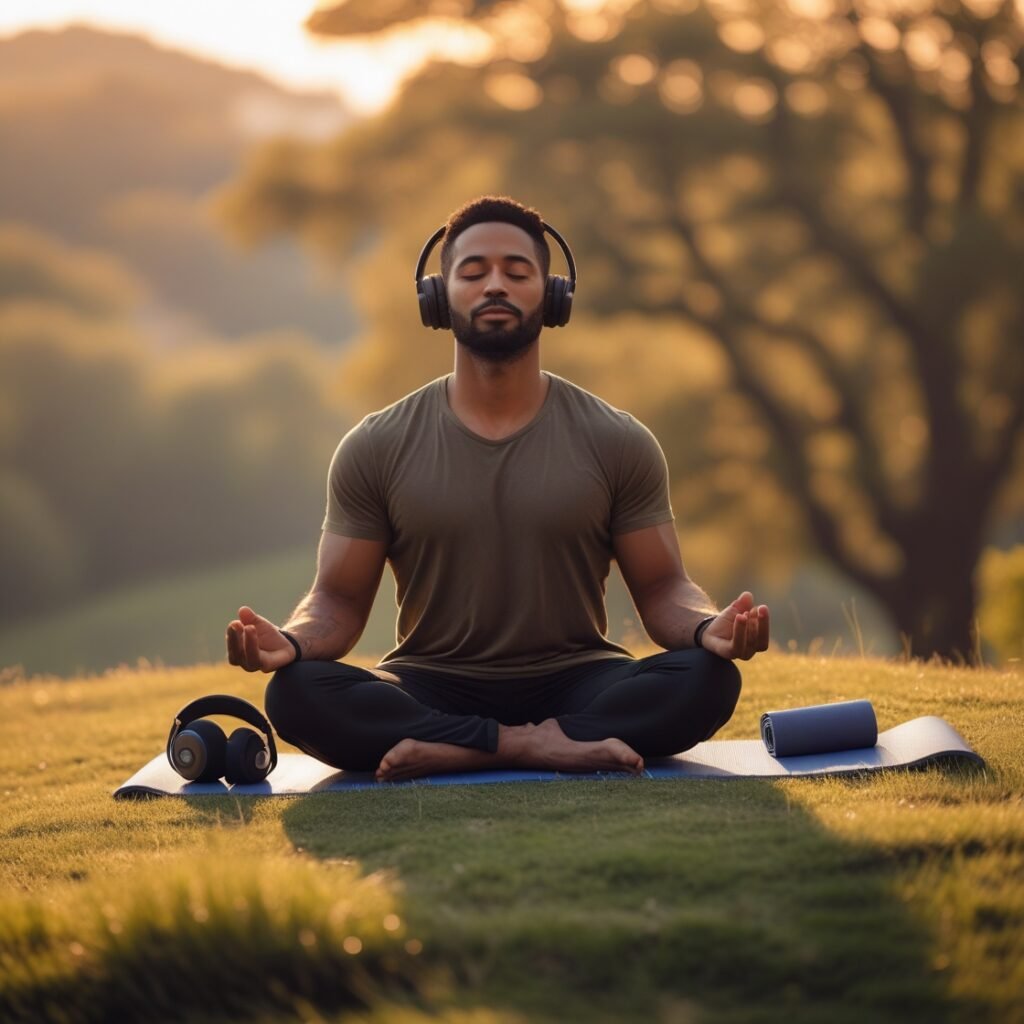Table of Contents
Introduction: What Is Guided Meditation & Why Should You Try It?
Have you ever felt overwhelmed by stress, struggled to quiet your mind, or wished for a simple way to unwind? You’re not alone. In today’s fast-paced world, finding moments of peace can feel like a luxury—but what if there was an easy, accessible way to reset your mind and body?
That’s where guided meditation comes in.
Unlike traditional meditation, where you might sit in silence and focus on your breath, guided meditation involves following a narrator’s voice—leading you through calming visualizations, breathing exercises, or body scans. It’s like having a personal mindfulness coach, making meditation effortless, especially for beginners.
Why Try Guided Meditation?
Research shows that just 10 minutes a day can lead to:
✔ Reduced stress & anxiety – Calms the nervous system and lowers cortisol levels.
✔ Better sleep – Helps quiet racing thoughts for deeper rest.
✔ Improved focus & clarity – Trains your mind to stay present.
✔ Emotional balance – Encourages self-awareness and resilience.
Whether you’re new to meditation or looking to deepen your practice, guided sessions remove the guesswork. No experience? No problem. All you need is a quiet space and a willingness to relax. Learn mor about how to use meditation for anxiety relief.
Ready to explore how guided meditation can transform your well-being? Let’s dive in.

The Science Behind Guided Meditation: How It Rewires Your Brain for Calm
Ever wondered why a 10-minute guided meditation can leave you feeling so refreshed? It’s not just “in your head”—it’s in your brain chemistry. Modern neuroscience reveals fascinating ways guided meditation impacts your mind and body, making it more than just relaxation—it’s a powerful tool for mental and physical well-being.
How Guided Meditation Changes Your Brain
Studies using MRI scans show that regular guided meditation:
- Strengthens the prefrontal cortex – Boosts focus, decision-making, and emotional regulation.
- Reduces amygdala activity – The brain’s “panic button” shrinks, lowering stress and anxiety.
- Enhances alpha & theta brainwaves – Linked to deep relaxation and creativity.
This means that over time, your brain literally rewires itself to stay calmer and more resilient—even outside meditation.
Proven Health Benefits (Backed by Research)
Guided meditation isn’t just placebo; science confirms its real-world benefits:
✔ Lowers cortisol – A 2013 study found 30% reductions in stress hormones after just 8 weeks of practice.
✔ Improves sleep quality – Harvard research shows it helps insomniacs fall asleep 20% faster.
✔ Boosts immunity – Regular meditators produce more disease-fighting antibodies.
✔ Reduces chronic pain – Mindfulness-based meditation can lower pain perception by 40%.
Why Voice Guidance Works So Well
Unlike silent meditation, guided sessions use verbal cues, storytelling, and binaural beats to:
- Keep beginners engaged (no more “Am I doing this right?”)
- Activate the default mode network (responsible for self-reflection and mental clarity)
- Trigger the relaxation response faster than unguided practice
The Takeaway? Consistency Is Key
Just like exercise, the benefits compound over time. Even 5 minutes a day can lead to measurable changes in mood, focus, and stress resilience.
Curious to experience it yourself? The next section breaks down exactly how to start—no prior experience needed.
How to Get Started with Guided Meditation: A Beginner’s Roadmap to Peace
So you’re ready to try guided meditation – but where do you begin? Don’t worry if you’ve never meditated before. Unlike traditional meditation that might leave you wondering “Am I doing this right?”, guided sessions are like having a personal mindfulness coach in your ear. Let’s break down exactly how to start your journey.
Step 1: Find Your Perfect Guide
With thousands of options available, here’s how to choose:
🔹 For absolute beginners: Look for short (5-10 min) sessions labeled “Introduction to Meditation”
🔹 For stress relief: Try body scan or loving-kindness meditations
🔹 For sleep: Search for “sleep stories” or “yoga nidra” guided sessions
Top-rated apps to explore:
- Headspace (perfect for beginners)
- Insight Timer (free with thousands of options)
- Calm (great for sleep stories)
Step 2: Create Your Meditation Space
You don’t need a zen garden – just a quiet corner where you can:
✓ Sit comfortably (chair or cushion)
✓ Minimize distractions (phone on silent)
✓ Set the mood (soft lighting optional)
Pro tip: Use the same spot daily to build a habit – your brain will associate this space with relaxation.
Step 3: Master the Basics of Practice
During your first sessions:
- Get comfortable (no need for lotus position)
- Follow the guide’s voice without judgment
- When your mind wanders (it will!), gently return focus
Common beginner mistakes to avoid:
✖ Expecting immediate results (it’s called a “practice” for a reason)
✖ Getting frustrated by thoughts (they’re normal!)
✖ Giving up after one try (consistency is key)
Making It Stick: Building Your Habit
Start small for big results:
- Schedule it: Tie meditation to an existing habit (like morning coffee)
- Track progress: Use a simple calendar checkmark system
- Be kind to yourself: Missed a day? Just begin again tomorrow
Remember: There’s no “perfect” way to meditate. What matters is showing up. Ready to take the next step? In the following section, we’ll explore different types of guided meditations to match your specific needs.
Different Types of Guided Meditation: Find Your Perfect Practice
Think all meditation is the same? Think again! Just like exercise has different styles for different goals, guided meditation offers varied approaches to suit your needs. Whether you’re seeking stress relief, better sleep, or emotional healing, there’s a perfect practice waiting for you. Let’s explore the most effective types and how to choose yours.
1. Mindfulness Meditation: Anchoring in the Present
Best for: Reducing anxiety, improving focus, managing overwhelming thoughts
What to expect:
- Gentle guidance to observe thoughts without judgment
- Focus on breath or body sensations
- Short sessions (5-15 minutes) ideal for beginners
“Mindfulness isn’t about emptying your mind – it’s about noticing what’s there without getting swept away.”
2. Body Scan Meditation: Releasing Tension
Best for: Physical relaxation, chronic pain, pre-sleep unwinding
How it works:
- Systematic focus on different body parts
- Releases muscle tension you didn’t know you had
- Often paired with progressive relaxation techniques
Try this tonight: Lie down and imagine a warm light slowly moving from your toes to your head, melting away tension.
3. Loving-Kindness (Metta) Meditation: Cultivating Compassion
Best for: Emotional healing, relationship challenges, self-acceptance
The practice:
- Silent repetition of positive phrases
- Extends goodwill first to yourself, then others
- Shown to increase empathy and reduce anger
Sample phrase: “May I be happy. May I be healthy. May I live with ease.”
4. Visualization Meditation: Harnessing Your Imagination
Best for: Goal achievement, anxiety relief, boosting creativity
Powerful variations include:
- Nature scenes (forests, beaches)
- Future self visualization
- Healing light imagery
Fun fact: Your brain often can’t distinguish between vivid imagination and reality – that’s why this works!
5. Yoga Nidra: Conscious Deep Rest
Best for: Deep relaxation, insomnia recovery, stress reset
Why it’s special:
- Done lying down (no flexibility required)
- Induces state between wakefulness and sleep
- 20 minutes = equivalent of 4 hours sleep for nervous system
Are you ready to know more about sleep meditation?
Matching Meditation to Your Needs
Use this quick guide to find your ideal type:
➤ Overthinking? → Mindfulness
➤ Muscle tension? → Body Scan
➤ Self-critical? → Loving-Kindness
➤ Need motivation? → Visualization
➤ Exhausted? → Yoga Nidra
Remember, there’s no “best” type—only what works for you right now. Your perfect practice might change with your needs, and that’s perfectly okay. In our next section, we’ll tackle common meditation challenges so you can move past obstacles and make this a sustainable habit.
Overcoming Common Meditation Challenges: Your Roadmap to Consistency

Ever sat down to meditate only to find your grocery list, work worries, or that embarrassing thing you said in 2012 suddenly demanding your attention? You’re not failing at meditation—you’re actually doing it right. The key isn’t to eliminate challenges, but to work through them with compassion. Let’s troubleshoot the most common meditation hurdles together.
1. “My Mind Won’t Stop Racing”
Why it happens:
Your busy mind isn’t a problem—it’s normal. Meditation isn’t about stopping thoughts, but noticing them without getting tangled up.
Try this instead:
- Imagine thoughts as clouds passing by
- Gently label them (“thinking,” “planning,” “remembering”)
- Return to your anchor (breath, body, or guide’s voice)
Remember: Each return to focus is like a bicep curl for your attention muscle.
2. “I Can’t Sit Still”
Solutions for the fidgety meditator:
- Start with just 2-5 minute sessions
- Try walking meditation (focus on footsteps)
- Use a comfortable chair instead of cross-legged
Pro tip: Physical discomfort often eases after the first few minutes as your body adjusts.
3. “I Keep Falling Asleep”
Is this you?
- Try meditating earlier in the day
- Sit upright instead of lying down
- Open your eyes slightly with soft gaze
Fun fact: If you’re falling asleep, your body probably needs rest—take it as useful feedback!
4. “I Don’t Have Time”
Time-saving hacks that work:
- Attach meditation to an existing habit (after brushing teeth)
- Try micro-meditations (even 60 seconds counts)
- Use idle moments (waiting in line, during commute)
Did you know? Three 1-minute mindful breaths spaced through your day can significantly lower stress.
5. “I’m Not Seeing Results”
Shift your perspective:
- Look for subtle changes (slightly calmer reactions)
- Track your mood pre/post meditation
- Remember benefits accumulate over weeks
Signs it’s working (that you might miss):
☑ Pausing before reacting to stress
☑ Noticing tension in your body sooner
☑ Waking up slightly more refreshed
The Secret No One Tells You
Meditation isn’t about achieving some perfect zen state—it’s about showing up consistently, even (especially!) on days when it feels hard. Every “failed” session where you noticed your distractions actually strengthened your awareness.
Your challenge isn’t a roadblock—it’s part of the path.
Ready to turn these insights into action? In our final section, we’ll explore how to make meditation a lasting habit that naturally fits into your life.
Conclusion: Your Journey to Mindful Living Starts Here
You’ve just explored the transformative power of guided meditation—from its science-backed benefits to practical ways to make it a daily habit. But here’s the most important thing to remember: meditation isn’t about perfection; it’s about practice.
Key Takeaways to Carry Forward
✅ Start small, stay consistent: Even 5 minutes daily creates lasting change
✅ Embrace the wobbles: A wandering mind means you’re human—not failing
✅ Find what works for YOU: Experiment until you discover your ideal meditation style
✅ Progress over perfection: The benefits build gradually, like compound interest

Your Next Steps
Why not try one of these simple actions today?
- Bookmark one guided meditation video or app for easy access
- Set a reminder for your first 3-minute session tomorrow morning
- Share this post with someone who’d benefit from more calm
A Final Thought
The busiest minds often need meditation most. Whether you’re seeking stress relief, better focus, or deeper self-awareness, remember: every great meditator was once a beginner. Your journey begins exactly where you are—not where you think you “should” be.
What will your first small step be today?
References
- Harvard Medical School (2018). “Mindfulness Meditation May Ease Anxiety, Mental Stress”. Harvard Health Publishing.
https://www.health.harvard.edu/mind-and-mood/mindfulness-meditation-may-ease-anxiety-mental-stress - National Center for Complementary and Integrative Health (NCCIH) (2021). “Meditation: In Depth”. U.S. Department of Health & Human Services.
https://www.nccih.nih.gov/health/meditation-in-depth - Goyal, M., et al. (2014). “Meditation Programs for Psychological Stress and Well-being”. JAMA Internal Medicine.
DOI:10.1001/jamainternmed.2013.13018 - Tang, Y.Y., et al. (2015). “The Neuroscience of Mindfulness Meditation”. Nature Reviews Neuroscience.
DOI:10.1038/nrn3916 - Khoury, B., et al. (2013). “Mindfulness-based Therapy: A Comprehensive Meta-analysis”. Clinical Psychology Review.
DOI:10.1016/j.cpr.2013.05.005 - American Psychological Association (APA) (2019). “What Are the Benefits of Mindfulness?”.
https://www.apa.org/topics/mindfulness/meditation - Zeidan, F., et al. (2011). “Brain Mechanisms Supporting the Modulation of Pain by Mindfulness Meditation”. Journal of Neuroscience.
DOI:10.1523/JNEUROSCI.5791-10.2011 - Black, D.S., & Slavich, G.M. (2016). “Mindfulness Meditation and the Immune System”. Annals of the New York Academy of Sciences.
DOI:10.1111/nyas.12998 - Ong, J.C., et al. (2014). “A Randomized Controlled Trial of Mindfulness Meditation for Chronic Insomnia”. Sleep.
DOI:10.5665/sleep.4010 - Fredrickson, B.L., et al. (2008). “Open Hearts Build Lives: Positive Emotions, Induced Through Loving-Kindness Meditation”. Journal of Personality and Social Psychology.
DOI:10.1037/a0013262




